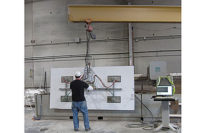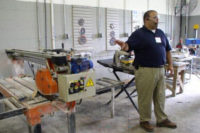
One key to shop safety is to maintain a clean, open floor with no debris or other hazards.
Despite all of the information out there on shop safety, we are still hearing about way too many accidents - often fatal accidents. My question is this:
How are your businesses addressing the issue of safety in the workplace? How formalized is your safety program? Do you hold regular safety meetings? Have you changed or expanded your approach to workplace safety in the past few years?
Ken Lago, Granite Countertop Experts LLC, Hampton, VA:There is nothing more important than safety in the workplace. We all want to go home at the end of the day; we don’t want to end up in hospital or at the morgue. Unfortunately, a lot of workplaces do little or nothing to drill that message home.
OSHA has always been seen as the “big bad wolf” in the eyes of shop owners and contractors, but their goal is to keep workers safe and the regulations they enforce should be embraced and implemented. Some people will say they can’t afford to do all of that and will ignore doing what they know is right.
There is too much to cover in one article about how to stay safe, so I will tell you what I do. I take all the safety courses that OSHA puts on their schedule in my area during the year, and even if the subject appears to not relate to my business, I take it anyway. I always leave the class with new knowledge. I will continue to do that every year and even repeat courses as needed. The courses are free, so there is no excuse for putting it off.
Dan Riccolo, Morris Granite, Morris, IL:Lifting and general handling are the dominant source of accidents in this industry. It is important to maintain all equipment, especially the handling equipment.
• We use vacuum lifters throughout the shop mounted on jib cranes. We regularly (daily) inspect the foam pads and the hydraulic cylinders.
• The hoists are cleaned, greased and inspected every six months.
• We try and keep the floor clean and clear. This is challenge in this industry, so we scrub the floor clean every day and try to never have debris laying on the floor or in the way.
• We always have two people present in the shop or at the jobsite.
• We have a wet shop, so dust is not a major issue - or even a minor one.
• The transport carts, frames and dollies are taken out of service immediately and not returned to service until properly repaired and/or replaced.
• Worn diamond blades and Velcro pads are disposed of when noticed.
• Ear plugs and safety glasses are worn in the workshop.
• Visitors are steered clear of the machines while they are being operated. Noise is reduced when visitors are present by not using the hand tools (saws, polishers).
• We inventory all the supplies (pads, core bits, blades) we normally use, so fresh consumables are readily available to the crew when they notice a dangerous level of wear.
• We hold a safety meeting once a month, where everyone present (office and shop personnel) has free reign on the safety topic.
Jean Marie Schneider, Custom Marble & Granite, Butler, PA:We have implemented monthly format safety meetings and a daily review of practices. In January, we discussed safety while operating the forklift. The major point of the meeting was that verbal instructions are not sent and received as intended and that all communications from the operator to the slab handlers can not be verbal alone and should always be reinforced with hand signals.
February was positioning, safe distance and escape route while moving/handling slabs.
Richard C. Roberts, Northwood Machine Mfg. Co., Louisville, KY:As an OEM of large-format equipment, the simplest form of safety practice related to automated equipment is Lockout/Tagout (LOTO). You can Google LOTO standards and discover many articles concerning these programs and their implementation. The simplest way to think about it when developing a plan for any piece of equipment is to consider stored energy. Air, water, electricity and even gravity in some cases need to be considered when preparing a piece of equipment for service. All these elements must be either properly drained of energy or rendered isolated from movement.
Lastly, I stress that operators of any equipment be properly trained on the safe operation and maintenance of the equipment.
Miles Crowe, Crowe Custom Countertops, Inc., Atlanta, GA:About a year and a half ago, we got very serious about safety. I had started to notice that my guys were putting safety concerns secondary to the need to “get the job done.” I called in a friend of mine who had retired as the head of safety for a very large company. He came in to consult us and start a formal safety program.
The first thing he was able to find out was that the granite industry was listed as a “target industry” on OSHA’s Web site. What this meant (as I understood it) was that OSHA could drop by unannounced at anytime and check for certain things (specifically air quality and noise). My consultant’s recommendation was that I enroll in the OSHA voluntary compliance program, which was administered through a local university. We immediately did so.
It was not painless. But it was much less difficult than I had imagined. The goal of the program was to make us safe, not to make life difficult. The main focus was to implement a formal safety program with training, procedures, and protocol. We had to retrain our employees on the safe way to do tasks that, in some cases, they had been performing for seven or eight years.
My biggest area of concern was material handling. Now, anyone that operates a crane or forklift at our shop has been trained and certified. Anyone assisting in moving pieces has been trained. Even our salespeople have had to go through training.
We also underwent training on proper safe maintenance of equipment and vehicles. Every employee was required to receive training on proper Lockout/Tagout procedures specific to their equipment. Every employee is required to inspect his equipment, tools and work area prior to starting each day. Each employee fills out and submits a one-page form as to the condition of their workspace every day. (It takes about one minute). Our drivers must inspect their vehicles every day and submit an inspection report.
I could go on and on. But the most important thing we did by far was to make someone formally in charge of safety. He takes this job very seriously. He keeps (as is mandated by OSHA) safety records on file for each employee. He makes sure that any new product we buy comes with an MSDS sheet. He makes sure any new hire goes through the proper training to safely do their job.
The biggest change you can make is the change in attitude. There was some resistance when we started this program. We actually had to give guys time off without pay for non-compliance. But once everyone saw that we were serious and saw the benefits, everyone got on board. It’s an ongoing process, but I do feel that we now have a much safer work environment, and we’re still getting the job done.
The end result showed about six months ago. We did get an unannounced visit from OSHA. We invited them right in (I doubt we had a choice). We passed with flying colors.
Ken Lago, Granite Countertop Experts LLC, Hampton, VA:I want to point out that it can be overwhelming when you first decide to be proactive and do something about safety. The first step is to fix what you know is wrong, one thing at a time. Then you should get a safety consultant person in and have them make a list of the things you have missed. The first step is the hardest, but as things get fixed and programs are put in place, you will wonder why you didn’t do it earlier. Get started now and be safe.
Chris Ash, Unique Granite LLC., Georgetown, IN:One area of safety that is overlooked in a lot of shops is material handling. I know of many shops where slabs are moved with a forklift to the saw. But that’s it. From the saw, every piece is moved with a couple guys using their backs. That is way too dangerous, in my opinion, with all the water and debris that can be on the floor.
We did it this way for the first four years. But in the last few months, we have invested in material handling equipment. Gone are the days of lifting pieces weighing 500-plus pounds. Now we use a crane with a vacuum lifter to place and position parts throughout the shop. Not only is it safer, but it increases production as well - once again proving that a safe shop is a profitable shop.
Employees moving material manually all day long, makes for tired employees. Tired employees are at a greater risk to make mistakes, which can result in injuries to themselves and others.
Todd Luster, Tile Marble and Stone LLC, Shawnee, OK:Lots of good things mentioned here. In my opinion, there is a lot of misunderstanding with people and safety.
We make it a practice to take new hires and make sure they are aware that their own safety is their first and foremost responsibility, and not ours. Their second responsibility is their fellow employees. With this mindset, we will all be safest. There is no slab, tool or even person who they are to put themselves in harm’s way for. We then try to cover all of the do’s and don’ts, like the ones mentioned in all the posts. You can never cover them all, and it is a dynamic subject as experience progresses - as well as new tools being added. It is something that needs to be discussed on an as needed basis, and never to be put off if anyone sees something unsafe.
I will tell you another idea, as a Firefighter/EMT for 16 years. Contact your local fire station and invite them to come do a walkthrough of your facility, while operations are going on, like unloading slabs and equipment running. This is not an inspection; this is a chance for the guys who will be responding to you in the unfortunate event of an accident to understand what they might be getting into and how it is handled, as well as several sets of ideas at no cost. Most have no idea of how we do things in our industry and are amazed at all the hazards.
A few other things not mentioned that come to mind. With cell phones, as tough as it is, try to make it policy of no talking on them except on break. Never allow them while moving slabs in any way. This is dangerous to everyone.
Another thing often overlooked is flammables. What shop doesn’t use alcohol and acetone? Many people have no idea how dangerous it can be, even in small quantities. In drum quantity, be sure it is grounded against static shock, which can be tragic in the right condition.
My Battalion Chief lives by a mindset and teaches it - Everybody Goes Home.
It is taught as a mindset and a way of life that ensures safety on a broad set of subjects. It is done the same way, like a way of life, so “everybody goes home.” It is not a set of rules because the boss said I had to.
This is a good way to look at it in our business in this industry as well, as it’s a dangerous business. Never get lax!
Matt Lansing, Stone Innovations, Inc., Plover, WI:We have a formal training program in place. We hired an outside company to come in once a month to conduct the training programs, make sure all of our paperwork is compliant, and they also perform quarterly checks on the facility and the employees to make sure everyone is on the same page as far as their training and understanding of the safety protocols.
With the daily grind of taking in orders, putting out completed kitchens, and all of the Human Resources-related issues, having a fully compliant OSHA program was definitely taking a backseat when it should have been the first priority for us. We found it was much easier to hire an outside company to lead us with our data collection, compliance manuals and training programs. Plus the rate is much, much cheaper per month than it would have cost me to put an employee on the project when you figure it out per hour.
Now when we have new hires, we have everything together in one place, making it much easier to get the new guys up to speed. Plus, all of our employees are now forklift certified which is a good thing to get off of our backs.
For any companies out there that are not fully compliant or if they are not sure if they are fully compliant, I would certainly seek out a company to help you get there. It is much cheaper than you think, and it will help you save money - and more importantly - save lives down the road.


